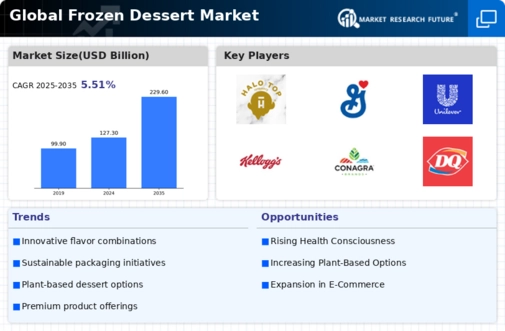Top Industry Leaders in the Frozen Dessert Market

The competitive landscape of the frozen desserts industry is as dynamic as it is diverse, reflecting evolving consumer preferences, technological advancements, and strategic innovations.
Strategies Adopted
Market leaders have also invested significantly in marketing campaigns, partnerships, and acquisitions to strengthen their foothold in the industry. Collaborations with popular restaurants, celebrities, or health-conscious influencers have been common strategies to expand consumer reach and reinforce brand image. Acquisitions of smaller, innovative companies with unique offerings have allowed these major players to diversify their product portfolios and capture new market segments rapidly.
Factors influencing market share analysis in the frozen desserts sector are multifaceted. Quality and taste remain paramount, alongside factors like price competitiveness, distribution channels, product availability, and responsiveness to changing consumer preferences. Health-conscious consumer behavior has led to a growing demand for healthier alternatives, including plant-based, organic, or low-calorie frozen desserts. Companies investing in research and development to meet these demands have gained traction in the market.
Emergence Companies
Moreover, the emergence of new and smaller players has intensified competition, adding dynamism to the market. Start-ups and emerging companies such as Halo Top, Talenti, and Jeni's Splendid Ice Creams have disrupted the industry with innovative recipes, unique flavors, and a focus on healthier ingredients. These companies often employ a niche marketing strategy, targeting specific consumer segments seeking artisanal, premium, or health-focused frozen desserts.
The industry is witnessing continuous developments and news, ranging from sustainability initiatives to technological advancements. Several companies are focusing on sustainable practices, incorporating environmentally friendly packaging and sourcing ethically produced ingredients. Moreover, advancements in technology, including cold chain logistics and novel freezing techniques, have enhanced product quality and shelf life, positively impacting market competitiveness.
Investment trends in the frozen desserts sector have reflected a growing interest from venture capitalists and private equity firms. Funding rounds for innovative start-ups, especially those offering unique, healthier alternatives, have seen a surge. Investors are keen on companies that demonstrate potential for scalability, disruptive product offerings, and a strong market fit, indicating a shift in investment focus towards innovation and differentiation.
Overall, the competitive scenario in the frozen desserts market is characterized by a blend of established giants and nimble newcomers, each employing diverse strategies to capture market share. The landscape continues to evolve, driven by changing consumer preferences, technological advancements, and a growing emphasis on health and sustainability. To thrive in this competitive arena, companies will need to remain agile, responsive to consumer demands, and innovative in their product offerings and marketing strategies.
Recent News :
Blue Bell Creameries have long dominated the market, leveraging their brand recognition, extensive distribution networks, and product diversification to sustain their positions. These industry giants have focused on product innovation, offering a wide range of Flavors, dietary options (such as low-sugar or dairy-free), and packaging innovations, catering to diverse consumer needs.
Key players
- Hain Celestial Group (US)
- Halo Top Creamery (US)
- General Mills Inc. (US)
- Unilever (UK)
- Nestlé SA (Switzerland)
- Kellogg Company (US)
- DD IP Holder LLC (US)
- Conagra Brands Inc. (US)
- London Dairy Co. Ltd (UK)
- Danone SA (France)
- Dairy Queen (US)
- Ferrero (Luxembourg)
- Daiya Foods Inc. (Canada)
- Archer Daniels Midland Company (US)
- Nestlé S.A. (Switzerland)
- Arla Foods amba (Denmark)
- and Unilever (UK)


